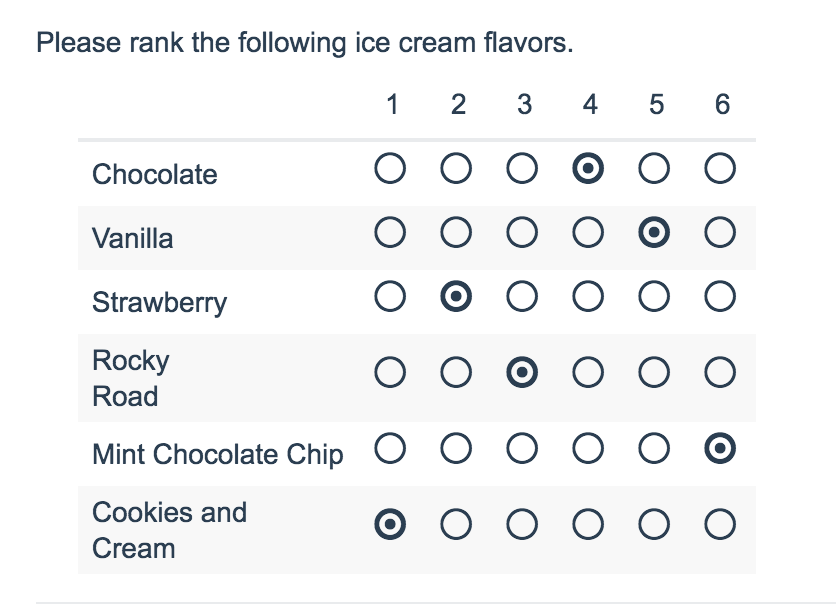
- Check it out in an example survey!
- Add a survey with this question to your account!
Ranking Grid questions allow respondents to rank a list of items in order, by selecting their numeric rank from a table of radio buttons, where each column is restricted to a single answer across all rows. This question type is designed as a numeric ranking, so you will not be able to put text into the column headers.
When To Use It
Use the Ranking Grid question to allow respondents to rank of list of items first to last. You can also use this question in place of Drag & Drop Ranking question for screen reader accessibility.
Limiting the Number of Items to be Ranked
By default, Ranking Grid questions will create the same number of columns as rows headers. This means that your results will rank each item (row) from highest to lowest.
If you prefer to gather the top 3 ranked items, you can do so by customizing the number of columns in your ranking questions. To do so:
- Edit your question and click the Validation tab.
- Enter the maximum number of columns you would like to display in the Limit answers to field.
- Click Save Question.

Your question should now reflect the number of column headers you indicated.

Logic
Ranking Grids can be targeted by logic but cannot be used to trigger a follow up question. Rows in a ranking grid cannot be shown/hidden.
Survey Taking
On a desktop and most laptops the Ranking Grid question type looks like so.

When optimized for mobile devices the Ranking Grid question type works a little differently as the small targets in grids are difficult to interact with on mobile devices. Instead respondents will need to click the options in order of their preference.
By default, survey questions show one at a time on mobile devices to prevent the need for scrolling on smaller screens. You can turn off this one-at-a-time interaction if you wish.

Reporting
Standard Report
In the Standard Report Ranking Grid questions report as a Diverging Stacked Bar Chart.

The table will include a row for each item in your Ranking Grid. Each item will have a Rank, Distribution, Score, and No. of Rankings.
- The Rank is assigned by the Score.*
- The Score is computed as described below.
- The No. of Rankings is the number of respondents that ranked that item. This can vary if the question is unrequired or you are limiting the number of items to be ranked.
- Finally, the Distribution is a diverging stacked bar where a shade is assigned to each possible rank (which usually corresponds to the number of items unless you are limiting the number of items to be ranked). At the midpoint, the color of the sections of the bar changes to help you to see where preference starts to fall off for each item. The width of each section is determined by the number of times that option assigned that rank.
*If the scores for multiple items are identical the Rank will be determined based on when the option was added to the question. Items added earlier will be ranked higher in the list.
See additional compatible chart types
Within the Standard Report there are various chart types available for visualizing your data. The below grid shows which of the chart types Ranking Grid questions are compatible with.
See what other report types are compatible
The below grid shows which of the report types Ranking Grid questions are compatible with. If you plan to do some specific analysis within Alchemer this report compatibility chart should help you choose the right question types!
| Report Type | Compatible |
|---|---|
| Standard | |
| Legacy Summary | |
| TURF | |
| Profile | |
| Crosstab | |
| Comparison |
Computing the Score
The score is a weighted calculation. Items ranked first are given a higher value or "weight." The score, computed for each answer option/row header, is the sum of all the weighted values. The weighted values are determined by the number of columns, which is usually the same as the number of rows but can be less if using the option to Limit Ranked Items.
For example, in the report above, because there are 6 options, the weighted sum for an option that was placed in the first position (1) would be worth 6. The table below shows the formula for computing the total rank for each answer option/row header:
| Total Responses | x | Weight | = | |
|---|---|---|---|---|
| Rank 1 Count | x | 6 | = | |
| Rank 2 Count | x | 5 | = | |
| Rank 3 Count | x | 4 | = | |
| Rank 4 Count | x | 3 | = | |
| Rank 5 Count | x | 2 | = | |
| Rank 6 Count | x | 1 | = | |
| + | Total Score (Answer Option X) |
If you had 7 instead of 6 answer options, then answer options chosen as Rank of 1 would be given a weighted value of 7 points, Rank 2 would be weighted 6 points and so on and so forth.
When items are not ranked e.g. there are 4 items, but only 2 are ranked OR if you are limiting the number of items to be ranked, the unranked items are given a score of 0 and the first ranked item is only given a score of 2 and second ranked is given a score of 1.
Exporting
If you'd prefer to look at your ranking data in more individual level or unsummarized format you can do so by exporting your data.
In CSV/Excel exports, each rank item will export as its own column. The column headers will first display the rank item and then the question title. In the row you can see the actual rank selected for each of your answer options in your ranking question. For each response (the row) the value in the cell for your that column or answer option is the rank selected by the respondent.

A Note About Piping Into Ranking Grid Questions
Ranking Grid questions use a weighted score that is based on the number of answer options. Because the number of options will vary when option piping, we discourage piping into a Ranking Grid as this can result in skewed data.
If you wish to pipe into a Ranking Grid, we recommend setting the minimum and max selectable options equal to each other in your source question. This way, each response has the same number of options and the weighted score is computed correctly.
Net Promoter®, NPS®, NPS Prism®, and the NPS-related emoticons are registered trademarks of Bain & Company, Inc., Satmetrix Systems, Inc., and Fred Reichheld. Net Promoter Score℠ and Net Promoter System℠ are service marks of Bain & Company, Inc., Satmetrix Systems, Inc., and Fred Reichheld.


